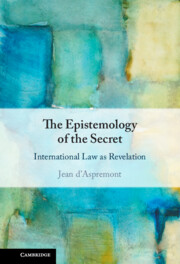Refine search
Actions for selected content:
5 results
1 - The Epistemology of the Secret of International Law
-
- Book:
- The Epistemology of the Secret
- Published online:
- 23 July 2025
- Print publication:
- 09 October 2025, pp 1-39
-
- Chapter
- Export citation

The Epistemology of the Secret
- International Law as Revelation
-
- Published online:
- 23 July 2025
- Print publication:
- 09 October 2025
Chapter 2 - Xanthus, Achilles’ Speaking Horse (Equus eloquens)
-
- Book:
- The Trojan Horse and Other Stories
- Published online:
- 09 November 2023
- Print publication:
- 11 January 2024, pp 33-62
-
- Chapter
- Export citation

The Trojan Horse and Other Stories
- Ten Ancient Creatures That Make Us Human
-
- Published online:
- 09 November 2023
- Print publication:
- 11 January 2024
13 - Derrida's reading of Heidegger
-
-
- Book:
- Interpreting Heidegger
- Published online:
- 11 April 2011
- Print publication:
- 17 March 2011, pp 273-298
-
- Chapter
- Export citation
